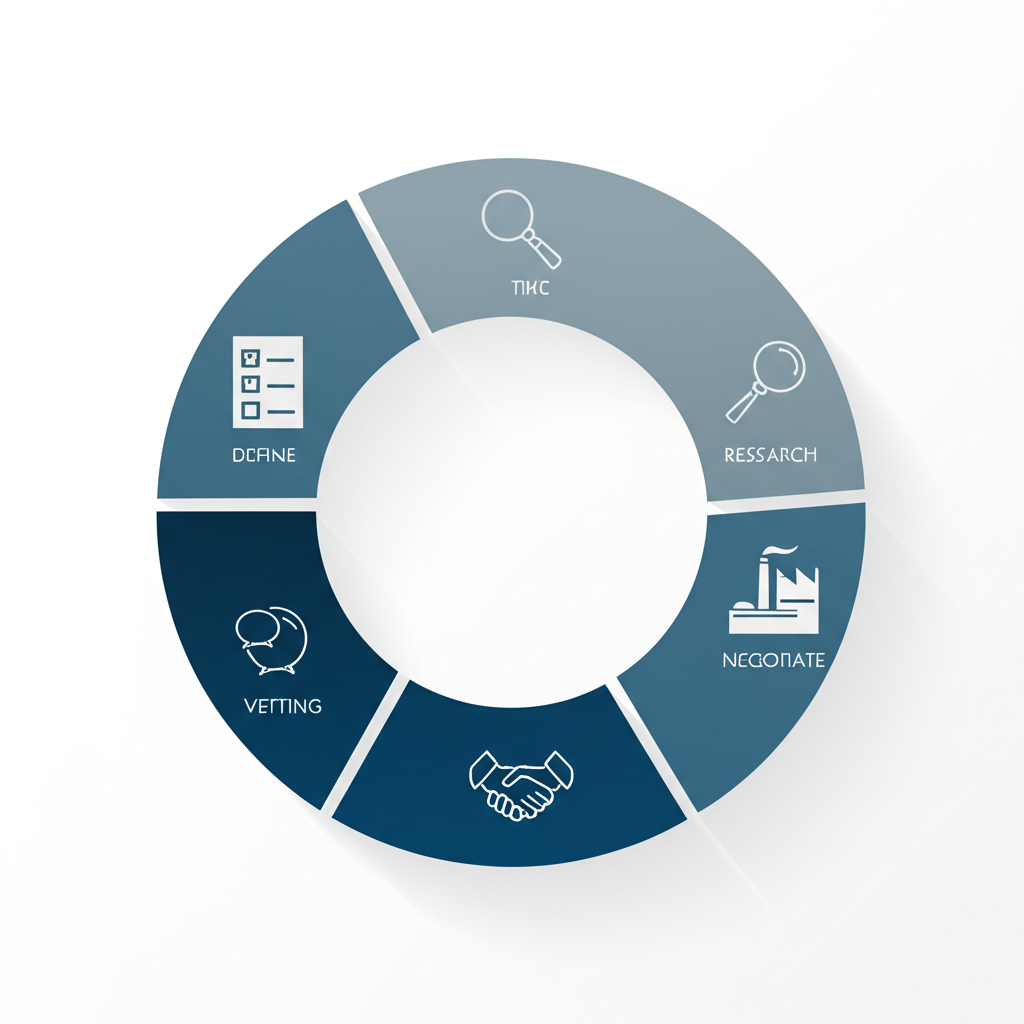Beyond the PO: Building a Long-Term Contract Manufacturer Partnership

TL;DR
Building a long-term partnership with a contract manufacturer is a strategic initiative that moves beyond a simple vendor transaction. Success hinges on a structured selection process, deep strategic alignment, and a steadfast commitment to clear, transparent communication. This approach not only ensures product quality but also strengthens your supply chain and fosters mutual growth.
Understanding the Foundation: Partnership vs. Vendor Relationship
In the world of manufacturing, the terms 'vendor' and 'partner' are often used interchangeably, but they represent fundamentally different approaches to business relationships. A vendor relationship is typically transactional; it's based on fulfilling a specific order for a set price. Communication is often limited to purchase orders and invoices, and the primary goal is cost efficiency for a single project. This model can be effective for simple, non-critical components, but it lacks the strategic depth required for complex or core products.
A true partnership, however, is a strategic alliance built on mutual success. As experts from GEP emphasize, effective collaboration is essential for achieving long-term goals. Partners are deeply integrated into each other's processes, sharing information, risks, and rewards. They engage in open, continuous dialogue about everything from product design improvements to market challenges. The focus shifts from short-term cost savings to long-term value creation, innovation, and supply chain resilience.
Choosing a partnership model requires a significant upfront investment in time and resources to find the right fit, but the returns are substantial. A partner acts as an extension of your own team, invested in your product's quality and success. This collaborative approach leads to better problem-solving, greater agility in the face of market changes, and a more robust, reliable production process. The table below highlights the key distinctions between these two critical relationship models.
| Factor | Vendor Relationship | Strategic Partnership |
|---|---|---|
| Goal Alignment | Transactional; focused on completing a single order. | Collaborative; focused on mutual long-term success. |
| Communication | Formal and infrequent (e.g., purchase orders, invoices). | Open, frequent, and proactive at multiple levels. |
| Approach | Reactive to client requests. | Proactive; offers suggestions for improvement and innovation. |
| Duration | Short-term or project-based. | Long-term and continuous. |
| Risk & Reward | Risk is siloed; rewards are not shared. | Risk and rewards are shared; success is interdependent. |

The 5-Step Process for Selecting the Right Manufacturing Partner
Finding a contract manufacturer that can evolve into a long-term partner requires a methodical and diligent approach. Rushing this process can lead to costly mistakes, production delays, and quality issues. Following a structured, five-step process ensures that you evaluate candidates thoroughly and select a partner that aligns with your technical, financial, and cultural needs.
This framework, outlined by resources like OpenBOM, guides you from initial planning to final contract, setting the stage for a successful and lasting collaboration.
-
Define Your Goals & Product Requirements
Before you begin your search, you must have a crystal-clear understanding of your needs. Document detailed product specifications, including materials, tolerances, and quality standards. Beyond the technical details, define your business objectives. Are you looking for cost reduction, scalability, access to specialized expertise, or faster time-to-market? Establishing these criteria upfront will provide a clear benchmark for evaluating potential partners.
-
Research and Shortlist Candidates
With your requirements defined, start identifying potential manufacturers. Use industry directories, attend trade shows, and leverage professional networks. When researching, look beyond basic capabilities. Assess their industry experience, client testimonials, and financial stability. For businesses in specialized sectors, finding a manufacturer with proven expertise is crucial. For example, companies needing high-precision automotive components might seek out providers like Shaoyi Metal Technology, which offers custom forging services certified for the automotive industry, demonstrating a deep understanding of sector-specific requirements and quality standards.
-
Conduct Thorough Vetting & Audits
Once you have a shortlist, the deep-dive due diligence begins. This is more than just a request for a proposal (RFP). As detailed in guides from NetSuite, you should request product samples, tour their facilities, and interview key personnel. A site visit allows you to assess their equipment, quality control processes, and workplace organization firsthand. Verify their certifications (like ISO 9001) and ask for references from current clients in your industry. This step is critical for validating their claims and getting a true sense of their operational capabilities.
-
Establish Budgets and Timelines
Engage in transparent discussions about costs and timelines. Provide your budget expectations and ask for a detailed cost breakdown, including tooling, materials, labor, and shipping. A true partner will work with you to find cost efficiencies without compromising quality. Likewise, establish realistic production timelines, including lead times for materials and ramp-up periods. Ensure the manufacturer has the capacity to scale production up or down to meet your demand forecasts.
-
Align on Values and Culture
A successful long-term partnership transcends technical capabilities; it requires cultural alignment. During your interactions, gauge their communication style, problem-solving approach, and commitment to transparency. Do they share your commitment to quality and ethical practices? A partner who is difficult to communicate with or whose values conflict with yours will create friction and undermine the relationship, regardless of their technical skill.
Building and Maintaining a Collaborative Partnership
Signing the contract is not the end of the process; it's the beginning of the partnership. Nurturing this relationship requires ongoing effort and a commitment to collaborative principles. The most successful partnerships are built on a foundation of trust, transparency, and communication. According to insights on successful business partnerships, both parties must be actively invested in cultivating the relationship to meet their shared goals.
Establishing Clear and Honest Communication Channels
Effective communication is the lifeblood of a strong partnership. Establish regular, scheduled meetings (weekly or bi-weekly) to discuss project status, address potential issues, and review performance metrics. Define clear points of contact on both sides to streamline decision-making and ensure accountability. Beyond formal meetings, utilize shared project management tools or dashboards to provide real-time visibility into the production process. Being upfront about timelines, potential delays, and challenges builds trust and allows for proactive problem-solving rather than reactive crisis management.
Ensuring Transparency with Data and Processes
Transparency is a critical component of trust. A reliable partner should be willing to share data related to production yields, quality control checks, and supply chain status. This openness allows you to have confidence in their processes and provides valuable insights for forecasting and planning. In return, you should be transparent about your sales forecasts, product roadmap, and any market changes that could impact demand. This mutual visibility helps both parties plan more effectively and adapt to changes with greater agility.
Following Through on Mutual Commitments
A partnership is a two-way street. Just as you expect your manufacturer to meet deadlines and quality standards, you must fulfill your commitments regarding timely payments, clear requirement definitions, and accurate forecasting. Consistently delivering on promises reinforces mutual respect and demonstrates a shared dedication to the partnership's success. When both sides honor their commitments, it creates a positive feedback loop that strengthens the relationship over time, transforming it from a simple contract into a powerful strategic alliance.
Navigating the Benefits and Risks of Contract Manufacturing
Entering into a long-term agreement with a contract manufacturer offers significant strategic advantages, but it's essential to approach the partnership with a clear understanding of both the potential rewards and the inherent risks. A well-structured partnership can become a powerful competitive advantage, while a poorly managed one can introduce significant vulnerabilities.
Pros
One of the most significant benefits, especially in today's volatile market, is the mitigation of supply chain risk. As highlighted by experts at Athena Manufacturing, a long-term agreement allows a manufacturer to secure materials and guarantee capacity in advance, ensuring a stable supply of parts. This predictability also leads to higher-quality parts, as the manufacturer gains experience and refines processes through repeated production runs. Furthermore, long-term volume commitments often result in lower per-part costs and reduce indirect labor, as your team spends less time on sourcing, negotiating, and onboarding new suppliers.
Cons
The primary risk in any outsourcing arrangement is the potential for intellectual property (IP) theft. Sharing sensitive product designs and proprietary processes with an external partner requires a high degree of trust and robust legal protections. A comprehensive non-disclosure agreement (NDA) and a clear contract outlining IP ownership are non-negotiable. Another risk is a potential loss of direct control over production processes and quality. To mitigate this, it's crucial to establish rigorous quality control protocols, regular audits, and clear performance metrics from the outset of the relationship.

Moving Forward: From Contract to Collaboration
Successfully building a long-term partnership with a contract manufacturer is a journey that transforms a simple supply chain link into a strategic asset. The process demands more than just finding a supplier who can meet a price point; it requires a deliberate effort to find an organization that aligns with your goals, quality standards, and values. By moving beyond a transactional vendor mindset and embracing a collaborative approach, your business can unlock profound benefits.
The key takeaways are clear: invest in a structured vetting process, prioritize open communication and transparency, and view your manufacturer as an integral part of your team. This strategic alignment fosters innovation, enhances product quality, and builds a resilient supply chain capable of navigating market uncertainties. A strong partnership is not merely a contract—it is a shared commitment to mutual growth and sustained success.
Frequently Asked Questions
1. How do you partner with a manufacturing company?
Partnering with a manufacturing company involves a structured process. Start by clearly defining your product requirements, budget, and long-term goals. Next, research and identify potential manufacturers, followed by a thorough due diligence phase that includes site visits and capability assessments. After selecting a suitable candidate, negotiate a detailed contract that outlines quality standards, pricing, and IP protections. Finally, establish clear communication channels and collaborative processes to manage the ongoing relationship.
2. How do you build long-term relationships with suppliers?
Building long-term relationships with suppliers goes beyond contracts. It requires fostering trust through transparency, maintaining open and honest communication, and consistently meeting mutual commitments. Treat your supplier as a strategic partner by sharing relevant business forecasts and involving them in product development discussions. Regularly review performance together and work collaboratively to solve problems and identify opportunities for continuous improvement.
3. How risky is contract manufacturing?
Contract manufacturing carries risks, with the most significant being the potential for intellectual property theft. Sharing proprietary designs and processes requires strong legal agreements and a trustworthy partner. Other risks include a loss of direct control over quality and potential supply chain disruptions if the manufacturer faces operational issues. These risks can be mitigated through careful vetting, robust contracts, regular audits, and maintaining a collaborative, transparent relationship.
4. What is a manufacturing partnership?
A manufacturing partnership is a strategic, collaborative relationship between a business and a contract manufacturer. Unlike a simple vendor relationship, which is purely transactional, a partnership is built on shared goals, mutual trust, and open communication. The manufacturer is often integrated into the business's processes, contributing to design, quality, and efficiency improvements to drive mutual success.
 Small batches, high standards. Our rapid prototyping service makes validation faster and easier —
Small batches, high standards. Our rapid prototyping service makes validation faster and easier — 
